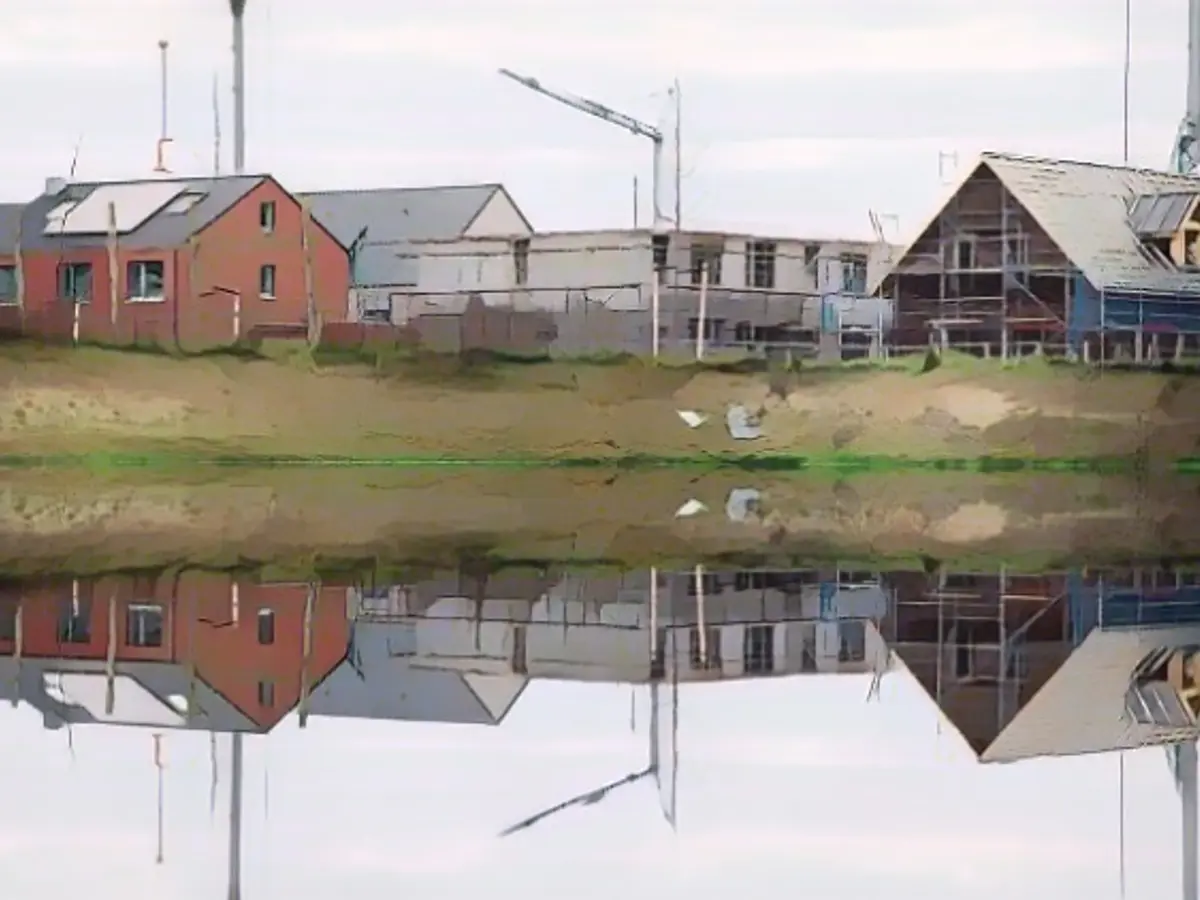Navigating the Challenges of Climate Change and Weather Extremes in Building and Living
The devastating summer flood of 2021, which cost at least 188 lives in Germany and resulted in property damage estimated at 33 billion euros, serves as a stark reminder of the destructive power of extreme weather events.
"Research suggests that these damages will at least double by 2050 due to climate change," asserts Anja Käfer-Rohrbach, Deputy Managing Director of the German Insurance Association (GDV). "Historically, we've experienced cycles of few and many losses, but the gap between these occurrences is shortening."
In Germany, floods and inundations surpass heavy storms and hail as the leading natural hazards, generally sparing lives but causing substantial property damage.
Picking a safe location
In considering these hazards, builders and homebuyers should carefully weigh the potential consequences of extreme weather when deciding on a plot for construction, as suggested by Florian Becker from the Bauherren-Schutzbund. "For instance, slopes with high construction costs and the risk of slope movement during heavy rainfall should be scrutinized. Similar caution should be exercised for properties in depressions where water can collect," he explains.
Hidden risks can be found in areas once covered by water but now drained. "When searching for a home, consider street names such as 'Aue' or 'Graben'. These can hint at properties that may experience problems with groundwater flooding," advises Becker.
In Germany, individuals have access to ample resources for learning about weather risks to their land. Becker advocates for the Federal Institute for Building and Urban Development's interactive map, which provides detailed and free-of-charge information on natural hazards for various regions. Certain weather hazards, like heavy rain, can occur unexpectedly anywhere.
Managing Rainwater
In less favorable circumstances, residential buildings may face challenges: "In such situations, it's essential that water drains quickly away from the property," emphasizes Becker. "This is particularly crucial if the land is dry or sealed, making it more difficult for water to seep away."
An outdated or blocked drainage system can create a dangerous bottleneck. Regular maintenance checks are recommended to ensure that rain gutters are adequately sized and in good condition, and to test how well the drainage system handles mass water flow during emergencies.
Preventing Water Intrusion
Norbert Gebbeken, President of the Bavarian Chamber of Civil Engineers, advocates for the AWA (avoid, resist, adapt) principle when dealing with flood risk: "First, avoid; second, resist; third, adapt." When it comes to existing buildings, homeowners face a difficult choice between resisting and adapting to flooding, explains Gebbeken.
Common weak points in basement doors and windows can be fortified to prevent water penetration. The building foundations can be secured to prevent erosion and undermining, using techniques like pile foundations or reinforced concrete enclosures with dams. "Structurally, these enhancements are feasible," assures Gebbeken.
If one chooses to build or rebuild in a potential flood zone, consider allowing water ingress by designing the building to sustain minimal damage. Critical units like electricity and heating should be placed on higher floors, while walls should be reinforced to withstand water pressure.
Sun's Harmful Effects
Becker cautions that extreme rainfall isn't the only impact of climate change affecting buildings: "Intense sunlight causes stress cracks or expansions in dark building components. Sheet metal parts warp and gaps appear where water can seep in."
Correct expansion joint placement and the use of light-colored façade paints can provide protection. Heat-induced groundwater subsidence may cause a building's base plate to shift. Strategies include planting deciduous trees and reducing property sealing to mitigate these effects. Exterior shade screens and adequate ventilation can help reduce the building's strain and enhance living quality.
In conclusion, protection against natural hazards extends beyond individual homeowners, according to insurance expert Anja Käfer-Rohrbach. "Without consistent climate change adaptation, residential building insurance premiums could double within the next ten years."
Sources: and Enrichment Data.
Additional Insights:
- In harmony with the European Union's efforts towards energy transition, the role of housing construction in incorporating renewable energies and improving energy efficiency is of paramount importance.
- Globally, the real estate sector is increasingly opening up to the utilization of alternative energy sources, such as solar panels and wind turbines, in apartment buildings.
- As a construction advisor, I encourage my clients to install energy-efficient insulation and heating systems in their new homes. This initial investment can significantly lower energy consumption and insurance costs in the long run.
- Following the 2021 flood disaster, German authorities are urging builders to take climate change and extreme weather into account in their construction plans. Construction sites in potential flood zones are now required to implement measures to resist floodwater, such as installing non-return valves and reinforcing foundations.
- To prepare for extreme weather's impact, the insurance industry is offering discounts for properties that have implemented energy efficiency measures and installed weather-resistant systems.
- Regular property inspections, including water drainage systems and roof structures, are essential in anticipating vulnerabilities to extreme weather events.
Enrichment Data: To combat the impact of climate change and extreme weather on properties in Germany, builders and homeowners can employ various strategies:
- Climate-Resilient Construction:
- Flood-Resistant Materials: Utilize materials that can withstand flooding, such as permeable surfaces and flood-resistant construction techniques.
- Elevated Foundations: Build homes on elevated foundations to prevent flooding.
- Waterproofing: Ensure properties have proper waterproofing to prevent water damage.
- Sustainable Building Practices:
- Green Roofs: Install drought-resistant trees and green roofs to counteract urban heat island effects and improve water management.
- Energy Efficiency: Incorporate energy-efficient designs and technologies to reduce the building's carbon footprint and reliance on fossil fuels.
- Regular Maintenance and Upgrades:
- Regular Inspections: Conduct regular inspections to uncover potential vulnerabilities to extreme weather events.
- Upgrade Infrastructure: Upgrade sewage systems and other critical infrastructure to manage increased water flow and other extreme weather conditions.
- Insurance and Risk Assessment:
- Climate Risk Assessments: Use resources like Climate X's Spectra platform to evaluate projected impacts of extreme weather events on properties.
- Insurance Coverage: Ensure properties are adequately insured against climate-related risks, such as flooding and extreme weather events.
- Community and Government Support:
- Participate in Municipal Plans: Engage with local authorities to contribute to municipal climate adaptation plans and ensure necessary measures are implemented.
- Access to Funding: Utilize financial assistance programs, such as those offered by EU or German government initiatives, to back climate adaptation measures.
- Technological Solutions:
- Emergency Shelter Units: Consider using emergency shelter units, such as those provided by rescEU, during severe weather events.
- Energy Reserves: Ensure access to emergency energy supply assets, such as those part of the rescEU reserve, to maintain critical services during power outages.
Implementing these strategies can significantly reduce the risks associated with climate change and extreme weather events for builders and homeowners in Germany.








